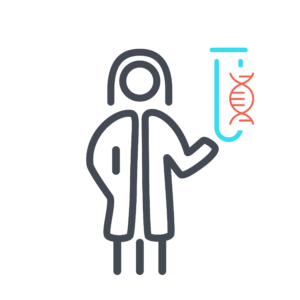GRIN2A-Related Syndrome

Table of contents
- What is GRIN2A-related syndrome?
- Key Role
- Symptoms
- What causes GRIN2A-related syndrome?
- Why does my child have a change in the GRIN2A gene?
- What are the chances that other family members or future children will have GRIN2A-related syndrome?
- How many people have GRIN2A-related syndrome?
- Do people who have GRIN2A-related syndrome look different?
- How is GRIN2A-related syndrome treated?
- Behavior and development concerns linked to GRIN2A-related syndrome
- Medical and physical concerns linked to GRIN2A-related syndrome
- Where can I find support and resources?
- Sources and References
GRIN2A-related syndrome is also called GRIN2A-related disorder. For this webpage, we will be using the name GRIN2A-related syndrome to encompass the wide range of variants observed in the people identified.
What is GRIN2A-related syndrome?
GRIN2A-related syndrome happens when there are changes to the GRIN2A gene. These changes can keep the gene from working as it should.

Key Role
The GRIN2A gene plays an important role in brain cell communication, learning, and memory.
Symptoms
Because the GRIN2A gene is important for brain activity, many people who have GRIN2A-related syndrome have:
- Developmental delay
- Intellectual disability
- Learning disabilities
- Seizures
- Speech and language difficulties
- Features of autism
- Low muscle tone, also called hypotonia
- Movement issues
- Attention difficulties
- Brain changes seen on magnetic resonance imaging (MRI)
What causes GRIN2A-related syndrome?
GRIN2A-related syndrome is a genetic condition, which means that it is caused by variants in genes. Our genes contain the instructions, or code, that tell our cells how to grow, develop, and work. Every child gets two copies of the GRIN2A gene: one copy from their mother’s egg, and one copy from their father’s sperm. In most cases, parents pass on exact copies of the gene to their child. But the process of creating the egg or sperm is not perfect. A change in the genetic code can lead to physical issues, developmental issues, or both.
Sometimes a spontaneous variant happens in the sperm, egg or after fertilization. When a brand new genetic variant happens in the genetic code is called a ‘de novo’ genetic variant. The child is usually the first in the family to have the genetic variant.
De novo variants can take place in any gene. We all have some de novo variants, most of which don’t affect our health. But because GRIN2A plays a key role in development, de novo variants in this gene can have a meaningful effect.
Research shows that GRIN2A-related syndrome is often the result of a de novo variant in GRIN2A. Many parents who have had their genes tested do not have the GRIN2A genetic variant found in their child who has the syndrome. In some cases, GRIN2A-related syndrome happens because the genetic variant was passed down from a parent.
Autosomal dominant conditions
GRIN2A-related syndrome is an autosomal dominant genetic condition. This means that when a person has the one damaging variant in GRIN2A they will likely have symptoms of GRIN2A-related syndrome. For someone with an autosomal dominant genetic syndrome, every time they have a child there is a 50 percent chance they pass on the same genetic variant and a 50 percent chance they do not pass on the same genetic variant.
Autosomal Dominant Genetic Syndrome
Why does my child have a change in the GRIN2A gene?
No parent causes their child’s GRIN2A-related syndrome. We know this because no parent has any control over the gene changes that they do or do not pass on to their children. Please keep in mind that nothing a parent does before or during the pregnancy causes this to happen. The gene change takes place on its own and cannot be predicted or stopped.
What are the chances that other family members or future children will have GRIN2A-related syndrome?
Each family is different. A geneticist or genetic counselor can give you advice on the chance that this will happen again in your family.
The risk of having another child who has GRIN2A-related syndrome depends on the genes of both biological parents.
- If neither biological parent has the same genetic variant found in their child, the chance of having another child who has the syndrome is on average 1 percent. This 1 percent chance is higher than the chance of the general population. The increase in risk is due to the very unlikely chance that more of the mother’s egg cells or the father’s sperm cells carry the same genetic variant.
- If one biological parent has the same genetic variant found in their child, the chance of having another child who has the syndrome is 50 percent.
For a symptom-free brother or sister of someone who has GRIN2A-related syndrome, the sibling’s risk of having a child who has GRIN2A-related syndrome depends on the sibling’s genes and their parents’ genes.
- If neither parent has the same genetic variant causing GRIN2A-related syndrome, the symptom-free sibling has a nearly 0 percent chance of having a child who would inherit GRIN2A-related syndrome.

How many people have GRIN2A-related syndrome?
As of 2025, about 400 people with GRIN2A-related syndrome have been identified in a medical clinic.

Do people who have GRIN2A-related syndrome look different?
People who have GRIN2A-related syndrome do not look different from others.

How is GRIN2A-related syndrome treated?
Scientists and doctors have only just begun to study GRIN2A-related syndrome. At this point, there are no medicines designed to treat the syndrome. A genetic diagnosis can help people decide on the best way to track the condition and manage therapies. Doctors can refer people to specialists for:
-
- Physical exams and brain studies
- Genetics consults
- Development and behavior studies
- Other issues, as needed
A developmental pediatrician, neurologist, or psychologist can follow progress over time and can help:
-
- Suggest the right therapies. This can include physical, occupational, speech, or behavioral therapy.
- Guide individualized education plans (IEPs).
Specialists advise that therapies for GRIN2A-related syndrome should begin as early as possible, ideally before a child begins school.
If seizures happen, consult a neurologist. There are many types of seizures, and not all types are easy to spot. To learn more, you can refer to resources such as the Epilepsy Foundation’s website: www.epilepsy.com/learn/types-seizures.

This section includes a summary of information from major published articles and the Simons Searchlight quarterly registry report. It highlights how many people have different symptoms. To learn more about the articles, see the Sources and References section of this guide.
Behavior and development concerns linked to GRIN2A-related syndrome
Genetic variants in GRIN2A-related syndrome result in either a gain of function of the GluN2A protein OR a loss of function of the GluN2A protein. It is not always obvious how a change in the GRIN2A gene will affect the GluN2A protein.
Researchers are working to understand the differences between gain of function and loss of function variants. Summarized below is our general understanding of the differences in people.
People with a GRIN2A loss of function variant tend to have:
- Mild medical features
- Speech disorders and/or seizures
- Mild or average intellectual disability
People with a GRIN2A gain of function variant tend to have:
- More medical features
- intellectual disability and seizures
Speech and learning
Many people with GRIN2A-related syndrome had global developmental delay and/or intellectual disabilities, from mild to profound.
- 111 out of 177 people had global developmental delay and/or intellectual disability (63 percent)
The severity of intellectual disability (ID) varied among people:
- 33 out of 74 people had mild ID (45 percent)
- 17 out of 74 people had moderate ID (23 percent)
- 8 out of 74 people had severe ID (11 percent)
- 16 out of 74 people had profound ID (22 percent)

Most people had speech and/or language disorders, including speech delays, regression, or inability to speak due to damage of the brain (aphasia).
- 129 out of 140 people had speech and/or language disorders (92 percent)
The severity of language disorders varied among people:
- 55 out of 115 people had moderate speech delay (48 percent)
- 18 out of 115 people were non-verbal (16 percent)
- 26 out of 115 people had speech delays (23 percent)
- 16 out of 115 people had speech regression or aphasia (14 percent)

Behavior
People with GRIN2A-related syndrome had behavioral issues, such as autism, attention-deficit/hyperactivity disorder (ADHD), anxiety, or schizophrenia. People with null variants (variants that cause no change in function of the GluN2A protein) tended to have mental health disorders.
- 17 out of 70 people had neurobehavioral diagnoses or concerns (24 percent)
- 6 out of 70 people had autism or features of autism (9 percent)
- 6 out of 70 people had ADHD (9 percent)
Brain
People with GRIN2A-related syndrome had low muscle tone (hypotonia), seizures, and/or changes seen on magnetic resonance imaging (MRI).
Seizure types included focal, generalized spasms, and epileptic spasms. Some people had seizures that were resistant to medications. People with null variants tended to have a later seizure onset (about 4 and a half years old) than people with missense variants (about 3 years old).
- 40 out of 139 people had hypotonia (29 percent)
- 192 out of 219 people had seizures (88 percent)
- 12 out of 85 people had changes seen on MRI (14 percent)

Medical and physical concerns linked to GRIN2A-related syndrome
Mobility
About 1 in 4 people with GRIN2A-related syndrome had a movement disorder, such as involuntary muscle contractions (dystonia), involuntary movements (chorea), and loss of muscle coordination and balance (ataxia).
- 19 out of 72 people had a movement disorder (26 percent)

Where can I find support and resources?
CureGRIN
CureGRIN is a foundation founded and run by parents who are committed to improving the lives of people living with GRI Disorders.
Simons Searchlight
Simons Searchlight is an online international research program, building an ever growing natural history database, biorepository, and resource network of over 175 rare genetic neurodevelopmental disorders. By joining their community and sharing your experiences, you contribute to a growing database used by scientists worldwide to advance the understanding of your genetic condition. Through online surveys and optional blood sample collection, they gather valuable information to improve lives and drive scientific progress. Families like yours are the key to making meaningful progress. To register for Simons Searchlight, go to the Simons Searchlight website at www.simonssearchlight.org and click “Join Us.”
- Learn more about Simons Searchlight – www.simonssearchlight.org/frequently-asked-questions
- Simons Searchlight webpage with more information on GRIN2A – www.simonssearchlight.org/research/what-we-study/grin2a
- Simons Searchlight GRIN2B Facebook community – https://www.facebook.com/groups/grin2a

Sources and References
The content in this guide comes from published studies about GRIN2A-related syndrome.
- Strehlow, V., Myers, K. A., Morgan, A. T., Scheffer, I. E., & Lemke, J. R. GRIN2A-related disorders. 2024 Jul 4. In: Adam MP, Feldman J, Mirzaa GM, et al., editors. GeneReviews® [Internet]. Seattle (WA): University of Washington, Seattle; 1993-2025. Available from: https://www.ncbi.nlm.nih.gov/sites/books/NBK385627/
